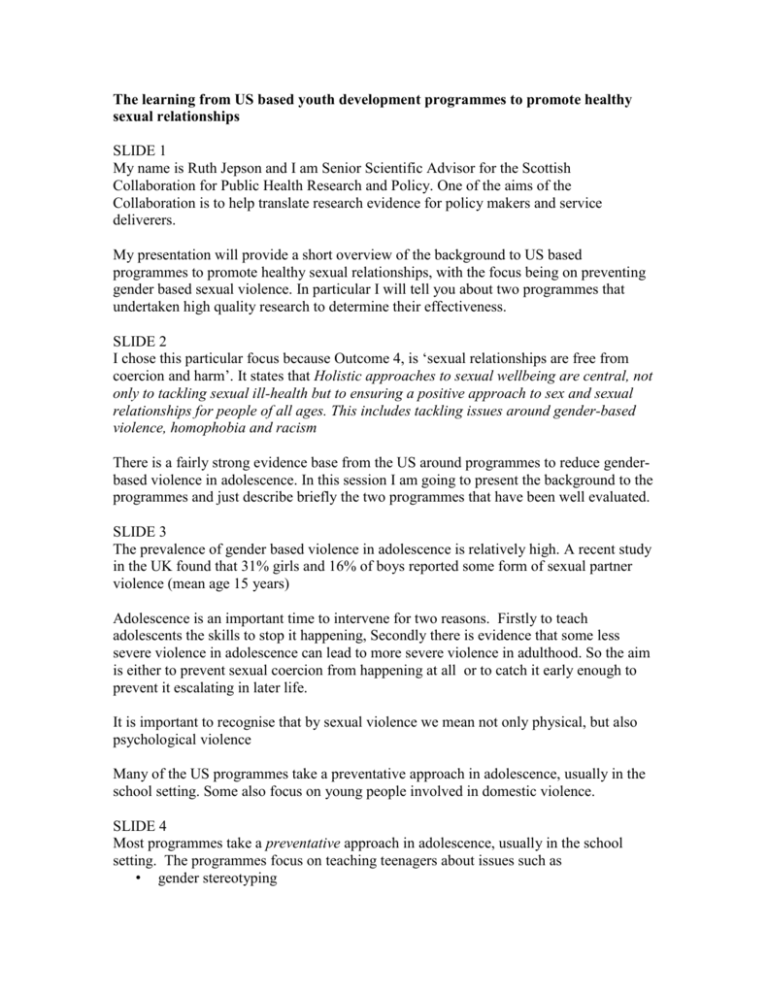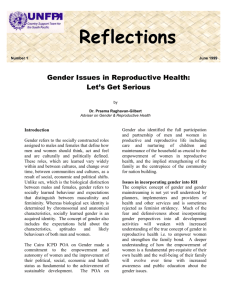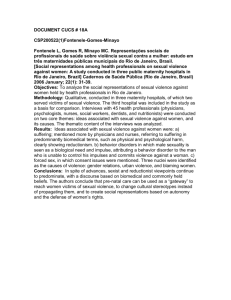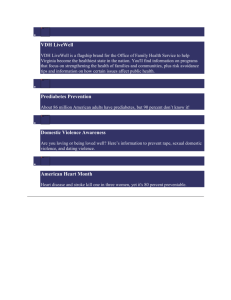
The learning from US based youth development programmes to promote healthy
sexual relationships
SLIDE 1
My name is Ruth Jepson and I am Senior Scientific Advisor for the Scottish
Collaboration for Public Health Research and Policy. One of the aims of the
Collaboration is to help translate research evidence for policy makers and service
deliverers.
My presentation will provide a short overview of the background to US based
programmes to promote healthy sexual relationships, with the focus being on preventing
gender based sexual violence. In particular I will tell you about two programmes that
undertaken high quality research to determine their effectiveness.
SLIDE 2
I chose this particular focus because Outcome 4, is ‘sexual relationships are free from
coercion and harm’. It states that Holistic approaches to sexual wellbeing are central, not
only to tackling sexual ill-health but to ensuring a positive approach to sex and sexual
relationships for people of all ages. This includes tackling issues around gender-based
violence, homophobia and racism
There is a fairly strong evidence base from the US around programmes to reduce genderbased violence in adolescence. In this session I am going to present the background to the
programmes and just describe briefly the two programmes that have been well evaluated.
SLIDE 3
The prevalence of gender based violence in adolescence is relatively high. A recent study
in the UK found that 31% girls and 16% of boys reported some form of sexual partner
violence (mean age 15 years)
Adolescence is an important time to intervene for two reasons. Firstly to teach
adolescents the skills to stop it happening, Secondly there is evidence that some less
severe violence in adolescence can lead to more severe violence in adulthood. So the aim
is either to prevent sexual coercion from happening at all or to catch it early enough to
prevent it escalating in later life.
It is important to recognise that by sexual violence we mean not only physical, but also
psychological violence
Many of the US programmes take a preventative approach in adolescence, usually in the
school setting. Some also focus on young people involved in domestic violence.
SLIDE 4
Most programmes take a preventative approach in adolescence, usually in the school
setting. The programmes focus on teaching teenagers about issues such as
• gender stereotyping
–
–
–
–
dating violence norms
conflict-management skills
communication skills
relationship and social skills
Some are designed to be used (or can be used) in conjunction with teaching about other
issues such as alcohol and drug taking.
SLIDE 5
Here are some example of the different types of programmes undertaken in the USA
which focus on gender violence. The ones I have listed –apart from the Expect Respect in
England- have all been well evaluated and I will talk more about what I mean by that in a
moment, as well as providing more detail on the programmes themselves.
– Safe Dates programme (USA)
– The Fourth R (for relationships) (Canada)
– Expect Respect (USA)
– Expect Respect (England)
There is also one evaluated Sport’s based programme called ‘Coaching Men into boys’
SLIDE 6
Research Evidence
Research into effectiveness of US programmes has been going on for many years. Some
of these programmes have been running for well over 10 years
However a lot of the research measure success in how they have changed attitudes and
behaviour. Whilst these outcomes are a measure of success, I think many practitioners
would want to know, and rightly so, whether the programmes actually change behaviour
– such as physical violence, sexual violence and condom use. I think practitioners like
yourselves would also want to know that any change in behaviour was sustained beyond
the period that the programme ran. It is relatively easy to demonstrate an impact of
educational interventions in the short term, especially when you are only measuring
attitudes and knowledge. It is much more difficult to demonstrate that the programme
was effective in the longer term.
SLIDE 7
Although there are about 10 school based programmes running in the US and North
America, I wanted to focus on two in particular – Safe Dates, and the Fourth R as the
were the highest quality, measure behaviour as well as knowledge, and had longer term
follow up. We will be discussing the relevance of these to the Scottish Setting in our
workshop this afternoon.
SLIDE 8
The first programme I want to describe to you is called SAFE Dates
SLIDE 9
Aims
To prevent dating violence by changing dating violence norms, gender stereotyping,
conflict-management skills, help-seeking, and cognitive factors associated with helpseeking.
Components of the programme
School activities include theatre production, 10- session curriculum, poster contest.
Community activities include special services for adolescents in violent relationships
and community service provider training
SLIDE 10
Evaluation
Randomised controlled trial with 4 year follow up
Results
Adolescents reported significantly less physical, serious physical, and sexual dating
violence perpetration and victimisation 4 years after the programme.
SLIDE 11
The second study is called the Fourth R.
SLIDE 12
Aims
To provide a comprehensive school-based program designed to include students,
teachers, parents, and the community in reducing violence and risk behaviours. Uses a
thematic approach to reduce risk behaviours including:
– Violence/bullying
– Unsafe sexual behaviour
– Substance use
Components of the intervention
A 21-lesson curriculum delivered during 28 hours by teachers with additional training in
the dynamics of dating violence and healthy relationships.
Dating violence prevention integrated with core lessons about healthy relationships,
sexual health, and substance use prevention using interactive exercises.
Relationship skills to promote safer decision making with peers and dating partners
SLIDE 13
Evaluation
Randomised controlled study with 2.5 years follow-up
Outcomes
Self reported physical dating violence (PDV) within the past year,
physical peer violence, substance use, and condom use
Results
7.1% of boys in control group reported (PDV) vs 2.7% in project boys
12.1% of girls in control group reported (PDV) vs 11.9% in project girls
Condom use was increased
SLIDE 14
•
•
•
•
Two US youth based programmes have been found to have long term
effectiveness on changing behaviours
Both can be used in conjunction with other related programmes
Their relevance in other countries has not yet been evaluated.
The workshop this afternoon will focus more on the two evaluated programmes
and their relevance to the Scottish setting










